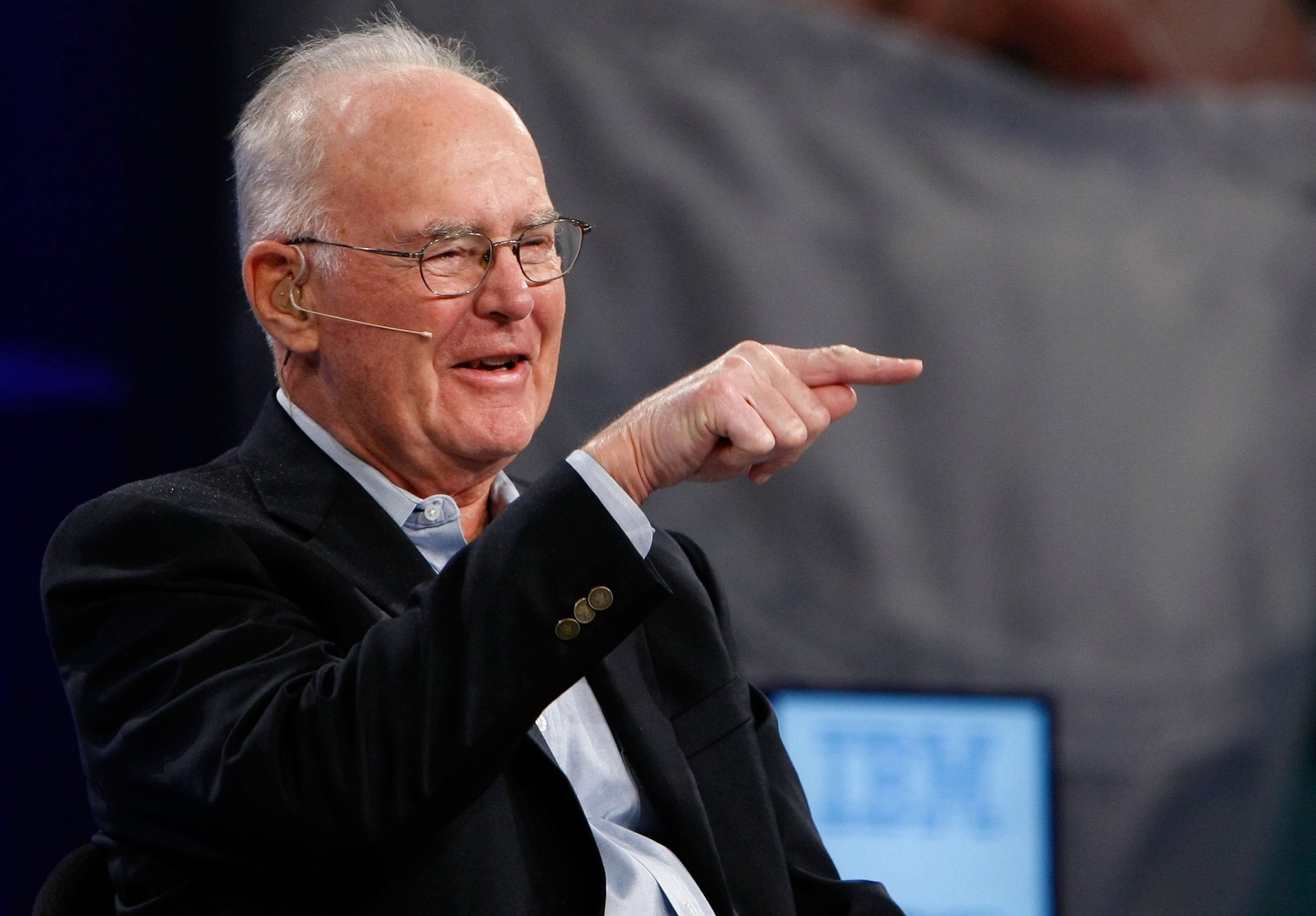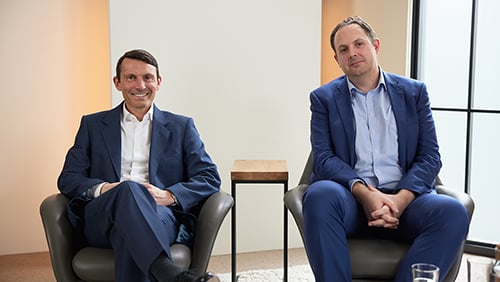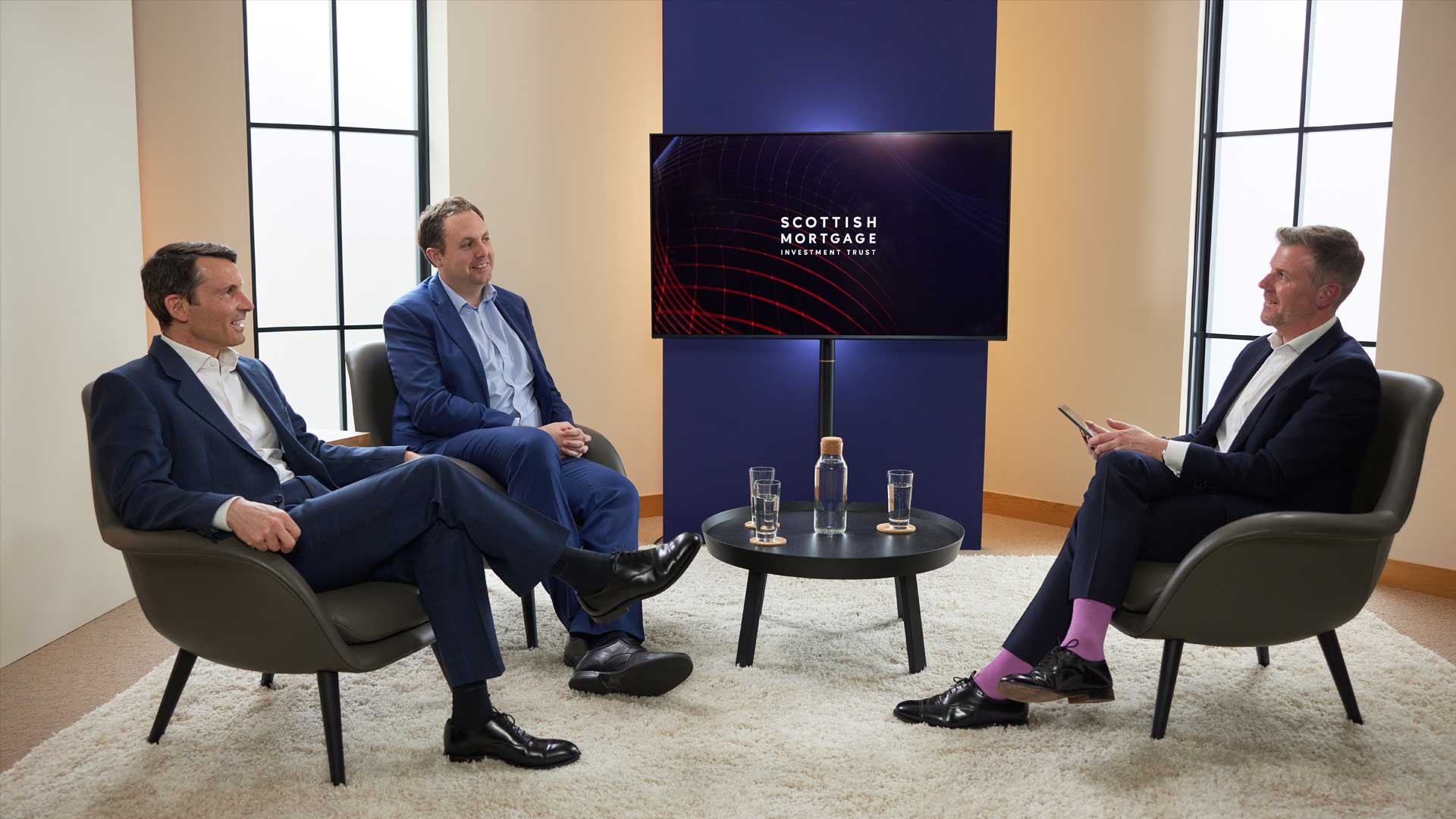What others teach us, lessons in investing
Lawrence Burns – Deputy manager, Scottish Mortgage
Deputy Manager of Scottish Mortgage Lawrence Burns shares the views of brilliant minds outside the industry that will reshape your view of what equity investing is all about.

All investment strategies have the potential for profit and loss, your or your clients’ capital may be at risk. Past performance is not a guide to future returns.
A conversation remains stuck in my head from early 2020, when the terms ‘lockdown’ and ‘social distancing’ were largely unheard of. My meeting with a Chief Investment Officer was coming to an end. We were discussing Tesla, which at the time was finally being recognised by the market and thus being rewarded with massive share price growth. He leaned across the table and said, “tell me you have been selling your shares.” What struck me was not his belief that we should sell, rather that he appeared to hold it with such absolute certainty. His assertion wasn’t anything to do with the company itself, but rather the ingrained belief that when a share price goes up a lot, you should sell. This was common sense. To do different would be foolish, greedy and undisciplined.
It is a conventional wisdom that pervades much of the financial industry. As the old saying goes ‘it’s never wrong to take a profit’. There is some validity in this approach, hence why it pervades and endures. A client is unlikely to be unhappy or indeed notice if you sell a stock that subsequently goes up significantly. That loss – of foregone upside – is not captured in performance data, but perhaps it should be. On the other hand, if the stock in question continues to be held and goes in the other direction it will become a clear detractor in performance data and you should expect to be asked, if not chastised, about it. And so, from the investment manager’s point of view, perhaps it can be said that it is never wrong to take a profit.
But what, I hope you ask, about the client? For the client, equity investing is asymmetric, the upside of not selling is near unlimited, while the downside is naturally capped. Surely, for the client it can be very wrong to take a profit? This goes to the heart of why so much of investing is wrong. Sadly, as an industry, institutional money managers too seldom try to get investment right for investors. Most conventions and practices exist to serve, protect and enrich investment managers’ interests.
The realities of investment therefore are often very different from the dogma. At Baillie Gifford, we are fortunate to be informed by a range of thinkers from outside our industry that have no incentive to prop-up the myths of investment management. Instead, they deal in observable facts, not the self-serving mantras beloved by professional investment bodies. This note tries to share a few of their perspectives that have been crucial to how we invest and, in the process, demonstrate that it is often not just wrong to take a profit, but it can be the worst possible mistake.
Professor Hendrik Bessembinder
Where Returns Actually Come From
Let’s take Bessembinder’s paper Do Stocks Outperform US Treasury Bills? as our starting point. We have all been told the answer is yes because stocks carry significantly more risk, so, of course the factual answer is no. Nearly 60 per cent of global stocks over the past 28 years did not outperform one-month treasury bills.
Equity investing as a whole though is thankfully still worthwhile. This is because of a small number of superstar companies. Bessembinder notes that a mere 1 per cent of companies accounted for all of the global net wealth creation. The other 99 per cent of companies were, it turns out, largely a distraction to the task of making money for clients. The capital asset price model (CAPM) so beloved by the financial industry is therefore nonsense because the normal distribution of stock returns that underpins it is imaginary.
This should shake the very foundations of the investment industry. It provides not an opinion but a collection of facts as to where returns come from and what investors should focus on. The entire active management industry should be trying to identify these superstar companies since nothing else really matters. Investing is a game of extremes.
But, here lies the problem, it requires a vastly different mentality to that displayed by the financial industry today. It requires focus on the possibility of extreme upside, not the crippling fear of capped downside. This requires genuine imagination should there be any hope to grasp the potential of superstar companies. After all, it required imagination to see that Amazon could become more than an online bookseller or that Tesla could become more than a premium electric car company.
In addition to imagination, Bessembinder makes it clear that it is the long-term compounding of superstar companies’ share prices that matters. Investing thus requires patience. This comes in two forms. Firstly, patience when things go wrong because even for superstar companies, progress is rarely a straight line. Many of our most successful holdings have had drawdown periods of 40 per cent. NIO was at one point down 85 per cent. It is important to not allow volatility to bully you out of a superstar company. The second type of patience is when things are going well. After all, the point of superstar companies is that they can go up five-fold and then go up five-fold again. If you sell after the share price merely doubles, crow and take your profits, you undermine the whole point of identifying companies with extreme return potential in the first place.
Let’s take a practical example. In early 2000, the founder of SoftBank, Masayoshi Son, made what may have been the greatest investment in history. He invested $20m in a Chinese ecommerce company. Two decades later his remaining investment is worth in excess of $180bn. A wonderful example of an extreme return.

This is a well-known story and one I’ve been lucky enough to be told first-hand by Masayoshi Son. However, less well-known is the story of Goldman Sachs. Goldman invested in the same company a year before Son on far better terms. Shirley Lin, who worked for its private equity fund, had an agreement to invest $5m for a 50 per cent stake. Ultimately though, they opted to invest $3m. Five years later their stake was worth $22m, a seven-fold return. At this point, the decision was taken to sell under the guise it’s never wrong to take a profit. In many ways, this was a remarkably successful investment, until you realise that today those shares would be notionally worth more than $200bn before dilutions are taken into account.
It would seem Goldman Sachs got the identification, and perhaps even the imagination part, right. They spotted one of the greatest superstar companies of our era early on. Yet, when asked why Goldman Sachs sold, Shirley gives a depressing but predictable answer: “they wanted quicker results”. Though this example is extreme and straddles public and private ownership, the point is clear: in investing, it is often not only wrong to bank profits, it can be the worst mistake you make. Despite this, in almost every client meeting I am asked about our sell-discipline. No one has ever asked me about our hold-discipline, which is a shame, as the greater cost to clients’ returns comes from the inability to hold onto superstar companies when their returns are ticking upwards. Investment managers are usually very good at selling. This doesn’t mean the answer is never to sell but rather to take such decisions very, very carefully. To sell too early can be catastrophic and far more costly than holding on too long.
Professor Brian Arthur
Increasing Returns to Scale
The notion that companies can even produce such extreme returns goes against much of economic theory which exhibits an overzealous equilibrium-mindset that likely has deep religious and spiritual roots. This mindset is the progenitor of a mindset of a different name common in finance, namely a belief in ‘reversion to mean’.
Bessembinder’s data falsifies the assumption that company returns quickly stabilise. Moreover, he shows when looking at nearly a century of US stock market returns the concentration of wealth creation is becoming yet more skewed towards a small number of companies. The returns are becoming extreme. The superstar companies are becoming more super.
This is particularly odd given that economics focuses on diminishing returns to scale. It takes the work of Professor Brian Arthur of the Santa Fe Institute, to understand that this concept is rooted in observing the returns to scale of the “bulk-processing, smokestack” industrial companies of the 19th century. He notes that western economies have shifted “from processing of resources to processing of information, from application of raw energy to application of ideas”. Far from diminishing returns, today’s knowledge-based companies tend to exhibit increasing returns to scale and so, in the digital era, reversion to the mean is even less common. Returns are yet more extreme.

Professor Ming Zeng
Network Companies Unleash Unimaginable Scale
Brian Arthur came up with this early explanation of emerging economic reality on America’s west coast, while observing both Silicon Valley and the rise of Microsoft further north. However, as with most things today, if we wish to better understand the economic reality of tomorrow, we must look east. To help us here we have the academic Ming Zeng. He became Alibaba’s Chief Strategy Officer in 2006, a job he took to further his studies by giving him a ringside seat to history in the making.
For Ming, the greatest superstar companies of the future will be what he calls “smart businesses” harnessing network coordination and data intelligence. These organisations will look less like a company and more like a network. He notes:
The old, diversified conglomerate was like a complex machine of the old industrial age. It collapsed when it reached a certain complexity. But the future of business is more biological rather than mechanical… an ecological system grows and becomes more and more sophisticated, even more robust when it becomes richer and more diverse.
Network companies, such as Amazon, Lyft or MercadoLibre, coordinate millions of entrepreneurs, guiding them with data intelligence in real-time so both the network companies and entrepreneurs can adapt to conditions instantly in ways traditional companies could never have dreamt. This marries the benefits of enormous scale with rapid adaptability. Moreover, the larger these network companies become, the more data they have and thus the more intelligent and effective the network can become. If Ming is right, then it is logical to assume the importance of superstar companies will grow even further with the application of machine learning.
The number of transistors incorporated in a chip will approximately double every 24 months.
Gordon Moore, Intel co-founder
Intel co-founder Gordon Moore. © Getty Images North America.
Massive Over Diversification
If we follow the facts and focus on superstar companies as the only real creators of value in long-run equity returns, then it also follows that portfolios need to be constructed radically differently. Given superstar companies are by their definition very rare, this makes concentration a logical response.
The case for concentration is well made in several academic studies. Yeung et al (2012) looked at nearly 5,000 funds and found that the top ideas in these portfolios consistently outperformed the diversified funds from which they were derived. Similarly, Best Ideas by Cohen, Polk and Silli (2010) highlighted that the top 5 per cent of fund managers’ ideas are consistently the best performers across portfolios, a point that is well supported by our own experience. The authors provocatively argue that stocks added ostensibly for risk control reasons are not just a mistake but a cynical exercise in enabling investment managers to add assets well beyond their alpha-generating capabilities. Our guess at the motivation for fund managers to diversify is somewhat different, but hardly better. We think investment managers embrace adding stocks so they can diversify their own business risk from the inherent volatility that comes with stock picking.

This raises a key question for institutional portfolio construction. Whose risk are we really trying to diversify? It can only rationally be that of the investment manager. For whilst the investment manager may have a few portfolios at most, the client often has many. Indeed, I have yet to meet a client for whom our portfolio represents their entire equity allocation. The investment manager therefore benefits from the diversification within their portfolio, not the client. They already own many thousands of stocks. The real problem for the client is not lack of diversification, but radical over-diversification.
If we combine this with what we know from Bessembinder, the client has two means by which they might capture the tiny number of superstar companies that have the potential to be meaningful for long-term returns. Pay low fees to own the index and never miss out on superstar companies but have them heavily diluted. Or, attempt genuine concentrated stock picking of superstar companies that actually justifies active fees. The middle ground between those two options too often risks serving investment managers, not the clients, providing only the worst of both worlds - active fees for index-like returns.
Conclusion
Finally, we should return to our opening and that conversation back in early 2020. The progress of Tesla since then has shown that we were wrong to hold. We should have added substantially. Of course, this shows that one never can be certain about the future. It is only through the brilliance of minds such as those noted here that we can start to grasp what actions and approaches might be most advantageous for our clients. This goes for building relationships not just with academics and scientists but corporate visionaries as well. It was the chance to talk to that company’s CEO to hear the ambition and vision that made it clear, though not certain, that the possibility of extreme upside was there.
About the author - Lawrence Burns
Deputy manager, Scottish Mortgage
Lawrence Burns was appointed deputy manager of Scottish Mortgage in 2021. He joined Baillie Gifford in 2009 and became a partner of the firm in 2020. During his time at the firm, his investment interest has become focused on transformative growth companies. He has been a member of the International Growth Portfolio Construction Group since October 2012 and in 2020 became a manager of Vanguard’s International Growth Fund. Lawrence is also co-manager of the International Concentrated Growth and Global Outliers strategies. Prior to this, he also worked in both the Emerging Markets and UK Equity teams. Lawrence graduated BA in Geography from the University of Cambridge in 2009.
Important information
This communication was produced and approved at the time stated and may not have been updated subsequently. It represents views held at the time of production and may not reflect current thinking.
This content does not constitute, and is not subject to the protections afforded to, independent research. Baillie Gifford and its staff may have dealt in the investments concerned. The views expressed are not statements of fact and should not be considered as advice or a recommendation to buy, sell or hold a particular investment.
Baillie Gifford & Co and Baillie Gifford & Co Limited are authorised and regulated by the Financial Conduct Authority (FCA). The investment trusts managed by Baillie Gifford & Co Limited are listed on the London Stock Exchange and are not authorised or regulated by the FCA.
A Key Information Document is available by visiting our Documents page.
Any images used in this content are for illustrative purposes only.







